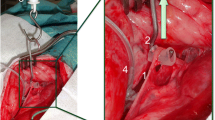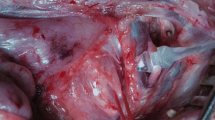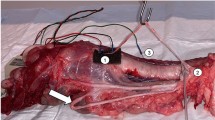Abstract
Introduction
The aim of this study was to investigate the regeneration potential of RLN after the compression of the nerve, without disrupting its continuity, using neuromonitoring.
Methods
In the first operation, the RLN and nervus vagus of adult Goettingen minipigs were dissected free, and the neuromonitoring parameters (amplitude, threshold and lag time of signal) were measured. Injury of the RLN was induced using a “bulldog” clamp. When the signal was no longer detectable, after the 15 min regeneration phase, the operation was finished. The neuromonitoring studies (see above) were repeated in a second operation 6 months later.
Results
(1) After the first operation, acute clamping of the RLN led to a reduction in the amplitude of the neuromonitoring signal; the lag time and the threshold of signal remained. Complete restitution of the signal was observed during the first regeneration phase. Repeated clamping led to complete disappearance of the signal. (2) During the second operation, i.e., after 6 months of regeneration, the neuromonitoring signals of both RLN and nervus vagus were detected in 93% of the GMP. No statistical differences (p = 0.17) were noticed between the amplitude of the RLN before the nerve injury (first operation) and after nerve regeneration (second operation). A significant increase in the lag time (p < 0.0005) was shown for both RLN and nervus vagus.
Conclusions
The acute compression of RLN can only be detected by observing the amplitude of the neuromonitoring signal. Restitutio ad integrum is possible after a short clamping period but it is important to preserve the RLN continuity.


Similar content being viewed by others
References
Bergamaschi R, Becouarn G, Ronceray J, Arnaud JP (1998) Morbidity of thyroid surgery. Am J Surg 176(1):71–75 doi:10.1016/S0002-9610(98)00099-3
Chan WF, Hung-Hin Lang B, Lo C-Y (2006) The role of intraoperative neuromonitoring of recurrent laryngeal nerve during thyroidectomy: a comparative study on 1000 nerves at risk. Surgery 140(6):866–873 doi:10.1016/j.surg.2006.07.017
Ready AR, Barnes AD (1994) Complications of thyroidectomy. Br J Surg 81:1555–1556 doi:10.1002/bjs.1800811103
Stremmel C, Hohenberger W, Klein P (2002) Results of laryngeal nerve monitoring during thyroid operations. Studies and value for clinical practice. Zentralbl Chir 127:400–403 doi:10.1055/s-2002-31980
Dralle H, Sekulla C, Haerting J, Timmermann W, Neumann HJ, Kruse E et al (2004) Risk factors of paralysis and functional outcome after recurrent laryngeal nerve monitoring in thyroid surgery. Surgery 136:1310–1322 doi:10.1016/j.surg.2004.07.018
Thermann M, Feltkamp M, Elies W, Windhorst T (1998) Recurrent laryngeal nerve paralysis after thyroid gland operations. Etiology and consequences. Chirurg 69:951–956 doi:10.1007/s001040050520
Lamade W, Meyding-Lamade U, Hund E, Senninger N, Herfarth C (1997) Transtracheal monitoring of the recurrent laryngeal nerve. Prototype of a new tube. Chirurg 68:193–195 doi:10.1007/s001040050173
Dralle H, Kruse E, Hamelmann WH, Grond S, Neumann HJ, Sekulla C et al (2004) Not all vocal cord failure following thyroid surgery is recurrent paresis due to damage during operation. Statement of the German Interdisciplinary Study Group on Intraoperative Neuromonitoring of Thyroid Surgery concerning recurring paresis due to intubation. Chirurg 75:810–822
Timmermann W, Hamelmann WH, Thomusch O, Sekulla C, Grond S, Neumann HJ et al (2004) Effectiveness and results of intraoperative neuromonitoring in thyroid surgery. Statement of the Interdisciplinary Study Group on Intraoperative Neuromonitoring of Thyroid Surgery. Chirurg 75:916–922 doi:10.1007/s00104-004-0858-0
Hamelmann WH, Meyer T, Timm S, Timmermann W (2002) A critical estimation of intraoperative neuromonitoring (IONM) in thyroid surgery. Zentralbl Chir 127:409–413 doi:10.1055/s-2002-31982
Jonas J (2002) Reliabilty of intraoperative recurrent laryngeal nerve monitoring in thyroid surgery. Zentralbl Chir 127:404–408 doi:10.1055/s-2002-31981
Neumann HJ (2000) Intraoperative neurophysiological monitoring (IONM) of the recurrent laryngeal nerve and microdissection. Surgical techniques for decreasing the risk of recurrent laryngeal nerve paralysis. Laryngorhinootologie 79:290–296 doi:10.1055/s-2000-343
Lamade W, Fogel W, Rieke K, Senninger N, Herfarth C (1996) Intraoperative monitoring of the recurrent laryngeal nerve. A new method. Chirurg 67:451–454
Woodson GE (2007) Spontaneous laryngeal reinnervation after recurrent laryngeal or vagus nerve injury. Ann Otol Rhinol Laryngol 116:57–65
Crumley RL, McCabe BF (1982) Regeneration of the recurrent laryngeal nerve. Otolaryngol Head Neck Surg 90:442–447
Araki K, Shiotani A, Watabe K (2006) Adenoviral GDNF gene transfer enhances neurofunctional recovery after recurrent laryngeal nerve injury. Gene Ther 13:296–303 doi:10.1038/sj.gt.3302665
Diener H, Hacke W (2002) Leitlinien für Diagnose und Therapie in der Neurologie. Thieme, New York
Bischoff C, Dengler R, Hopf HC (2003) EMG. NLG. Elektromyographie, Nervenleitungs-untersuchungen. Thieme, New York
Kimura J (1978) A method for determining median nerve conduction velocity across the carpal tunnel. J Neurol Sci 38:1–10 doi:10.1016/0022-510X(78)90240-X
Acknowledgements
The authors wish to thank A. Reichert, J. Weinberger, P. Heuler, and S. Endres for their assistance by the large animal operations and L. Stevenson-Knebel for her kind support in proofreading this paper.
Author information
Authors and Affiliations
Corresponding author
Additional information
Vasiliy Moskalenko and Markus Hüller contributed equally to this paper
Best of Endocrine Surgery in Europe 2008
Rights and permissions
About this article
Cite this article
Moskalenko, V., Hüller, M., Gasser, M. et al. Investigation of the regeneration potential of the recurrent laryngeal nerve (RLN) after compression injury, using neuromonitoring. Langenbecks Arch Surg 394, 469–474 (2009). https://doi.org/10.1007/s00423-008-0407-2
Received:
Accepted:
Published:
Issue Date:
DOI: https://doi.org/10.1007/s00423-008-0407-2




